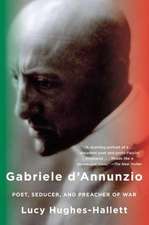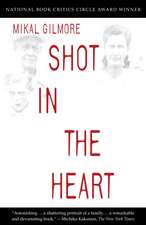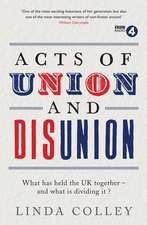The Ordeal of Elizabeth Marsh: A Woman in World History
Autor Linda Colleyen Limba Engleză Paperback – 31 oct 2008
Preț: 124.20 lei
Nou
Puncte Express: 186
Preț estimativ în valută:
23.77€ • 25.81$ • 19.97£
23.77€ • 25.81$ • 19.97£
Carte disponibilă
Livrare economică 01-15 aprilie
Preluare comenzi: 021 569.72.76
Specificații
ISBN-13: 9780385721493
ISBN-10: 0385721498
Pagini: 361
Ilustrații: 16 PP. B&W
Dimensiuni: 133 x 203 x 22 mm
Greutate: 0.4 kg
Editura: Anchor Books
ISBN-10: 0385721498
Pagini: 361
Ilustrații: 16 PP. B&W
Dimensiuni: 133 x 203 x 22 mm
Greutate: 0.4 kg
Editura: Anchor Books
Recenzii
"A dazzling performance of historical scholarship. . . . [Colley has] brought us a world in a book." —The New York Times Book Review“Vivid. . . . Marsh's extraordinarily peripatetic life illuminates not only the vast global changes of that period . . . but also the almost limitless resources of her own indomitable spirit.” —The New Yorker"Colley allows the reader to vault the pioneering life of an obscure woman . . . into a grander tale of physical hardiness and surprising moral choices" —The Economist“This is a remarkable book, both for its contents and because it is a new species of biography… Linda Colley has written a full-blown economic romance with an extraordinary range… bringing all the resources of her skills as a historian and researcher to her story. It is a major achievement and an enthralling narrative.”—Claire Tomalin, The Guardian“A work of skewering historical precision and vast imaginative reach… Colley’s style of irreproachable clarity makes light work of the global complexities of her story. Her synthesis of the facts is masterly… Her book is both moving and profound.”—Hilary Mantel, London Review of Books“Colley has had to piece together fragments of information from all kinds of sources; the result is a minor miracle of biographical reconstruction… Slave revolts in Jamaica, Moroccan politics, cod-fishing in the Shetlands, Manx smuggling, the responsibilities of naval wives, the organization of the salt industry in Bengal: all this, and more, is exposed to view.”—Noel Malcolm, The Sunday Telegraph“A refreshing and often startling narrative that opens fresh perspectives on a revolutionary era. The Ordeal of Elizabeth Marsh shifted my understanding of the eighteenth-century world.”—Linda K. Kerber, author of No Constitutional Right to Be Ladies: Women and the Obligations of Citizenship
Notă biografică
Linda Colley has taught at Cambridge, Yale, and the London School of Economics and is currently Shelby M. C. Davis Professor of History at Princeton University. Her book, Britons: Forging the Nation, 1707-1837, was a New York Times Notable Book and won the Wolfson Prize. Professor Colley writes for British and American periodicals and newspapers, including The Guardian, The Times, The New York Times, The Times Literary Supplement, and The London Review of Books.
Extras
Chapter One: Out of the Caribbean
The beginning prefigured much of the rest. She came to life against the odds, in a place of rampant death, and in the midst of forces that were already transforming large stretches of the globe.
The man who became her father, Milbourne Marsh, first set foot on Jamaica on 20 July 1732, which was when his ship, the Kingston, anchored off Port Royal.[1] The Kingston was one of a squadron of Royal Navy vessels ordered to the Caribbean that spring with instructions to deter smuggling in the region and attacks on British merchant shipping by Spanish armed coastguards, and to suppress any slave rebellions within Jamaica itself. Since wresting it from the Spanish in 1655, retaining this island had become increasingly important to the English, and subsequently to the British state, initially because of its location and size. Ninety miles south of Cuba, Jamaica was ideally situated for legal and illicit trade with Spain’s settlements in the Americas, and for staging attacks on them and on Spanish treasure ships, bearing gold and silver from New World mines back to Seville. At some 140 miles from east to west, Jamaica was also ten times larger than the rest of Britain’s Caribbean islands combined. Tropical, fertile and well-watered, it offered–for all its steep, mountainous interior and steamy forests — sufficient arable land, or so at first it seemed, to accommodate large numbers of incoming white smallholders. When Milbourne Marsh arrived, individuals of very modest means, indentured servants, shopkeepers, skilled labourers, cooks, peddlers, retired or runaway sailors, itinerants, pen-keepers (cow-farmers), garrison troops and the like still made up between a half and a third of Jamaica’s white population. But the island’s smallholders were in retreat before the rise of much larger landed estates and a single crop. Jamaica’s sugar industry did not reach the height of its profitability until the last third of the eighteenth century. Even so, by the 1730s, with over four hundred sugar mills, the island had comfortably overtaken Barbados as the biggest sugar-producer in Britain’s Empire.[2]
Although much of the technology employed on sugar plantations remained unchanged for centuries, these were still brutally innovative places. The unending work of planting, harvesting and cutting the sugar cane, milling it, boiling and striking the sugar syrup, transporting the finished products, rum, molasses, and the various sugars to the dockside, and loading them aboard ship, fostered task specialization, the synchronization of very large quantities of labour, and the imposition of shift systems and a ruthless time discipline.[3] Establishing the necessary mills, boiling houses and other fixed plant required large-scale capital investment; and plantation owners were acutely dependent on long-distance oceanic trade and communications to sell their products–and to recruit and import their workforces. As the historian David Eltis writes:
“The slave trade was possibly the most international activity of the pre-industrial era. It required the assembling of goods from at least two continents [Asia and Europe] . . . the transporting of those goods to a third [Africa], and their exchange for forced labour that would be carried to yet another continent [the Americas].”
Between a third and a half of the more than 1.2 million men, women and children purchased by British traders and carried in British ships from West Africa between 1700 and 1760 were probably landed in Jamaica. When Milbourne Marsh arrived here, the island contained almost eighty thousand black slaves, most of them recent arrivals from the Gold Coast, the Bight of Biafra and the Bight of Benin.[4]
There were other ways, too, in which Jamaica functioned as a laboratory for new ways of living and new types of people. Port Royal, Milbourne Marsh’s landfall on the island’s south-eastern coast, was an extreme case in point. The English had found its deep offshore waters, and its position at the end of a nine-mile spit separating Kingston harbour from the Caribbean, ideally suited for the loading and unloading of merchantmen from Europe and North America. Port Royal was also useful, they soon discovered, for piracy and for conducting contraband trade with, and raids against, Cuba, Hispaniola and mainland Spanish America. In 1688, 213 ships are known to have docked at Port Royal, almost as many as the total number calling that year at all of New England’s ports. With its almost seven thousand slaves, shopkeepers, merchants, sailors, book-keepers, lawyers, sea captains, craftsmen, wives, children, smugglers and ‘crue of vile strumpets and common prostratures’, the town was also more populous at this stage than its main competitor in British America, Boston, Massachusetts. And since its two thousand houses, many of them brick and some of them four prosperous storeys high, clustered together on barely fifty acres of gravel and sand, Port Royal was probably the most crowded and expensive English-speaking urban settlement outside London.[5]
Then came the earthquake. It happened at 11.43 a.m. on 7 June 1692. In ten minutes, two-thirds of Port Royal and two thousand of its citizens disappeared beneath the sea. A further three thousand died of injuries and disease in the days after:
“The sky, which was clear and serene, grew obscured and red throughout the whole extent of Jamaica. A rumbling noise was heard under ground, spreading from the mountains to the plain; the rocks were split; hills came close together; infectious lakes appeared on the spots where whole mountains had been swallowed up; immense forests were removed several miles from the place where they stood; the edifices disappeared . . . This terrible phenomenon should have taught the Europeans not to trust to the possessions of a world that trembles under their feet, and seems to slip out of their rapacious hands.”
In so describing its destruction, Abbé Raynal and his collaborators were adding an anti-colonialist twist to a tradition of moralizing disapproval of Port Royal that was in existence well before the earthquake.[6] Yet this lost town, a kind of maritime Pompeii, had been a dynamic and creative as well as a corrupt, exploitative place, and after the earthquake there were repeated attempts to rebuild it. They were aborted by a major fire in 1704 and a succession of hurricanes; and when Milbourne Marsh arrived, little remained of Port Royal except ‘three handsome streets, several cross lanes, and a fine church’, the nearby garrison, Fort Charles, and a small naval dockyard where ships from Britain’s Jamaica fleet were repaired and victualled. The town’s main commercial and slaving businesses had moved to nearby Kingston, which was more sheltered from the elements, and there were barely five hundred white inhabitants remaining in Port Royal, most of the men amongst them employed by the Royal Navy or as soldiers in Fort Charles.[7]
Port Royal’s most material legacy was arguably Jamaica’s developing sugar monoculture, since both the town’s gentile merchants and their Jewish counterparts had been important sources of credit for planters wanting to purchase land and slaves.[8] As this suggests, Jamaica was at once brutally divided by racial difference and violence, and in some respects also a cosmopolitan, even tolerant environment. The cosmopolitanism expressed itself in flamboyant consumerism. A taste for imported Chinese ceramics, for instance, seems to have been more prevalent in households in Port Royal before 1692, and in other Jamaican settlements, than in either British or mainland colonial American homes. At another level, British Jamaica resembled ‘a curious terrestrial space-station’ full of ‘fragments of various races, torn from the worlds of their ancestors’.[9] Most white incomers, like Milbourne Marsh himself, were young, single, male Protestants from southern England; but there were also Scots, Protestant and Catholic Irish, Portuguese-speaking Sephardic Jews from Brazil and Surinam, Huguenots, Dutchmen, occasional French and Spanish spies, smugglers and traders from nearby St Domingue and Cuba, and mainland American colonists, principally from Boston, New York and Philadelphia. There were about 8300 of these miscellaneous whites by the early 1730s, and the island’s ethnically and culturally diverse black population outnumbered them by more than ten to one.[10]
NOTES
[1] See the Lieutenant’s log: NMM, ADM/L/K 40A.
[2] ‘State of Jamaica’, c.1735: NA, PC 1/58/3. For the shifts in land ownership and sugar production on the island, see B.W. Higman, Jamaica Surveyed: Plantation Maps and Plans of the Eighteenth and Nineteenth Centuries (Kingston, 1988); and R.S. Dunn, Sugar and Slaves: The Rise of the Planter Class in the English West Indies, 1624—1713 (Chapel Hill, NC, 1972).
[3] For the Caribbean region as ‘precociously modern’ see, for instance, P.D. Morgan, ‘The Caribbean Islands in Atlantic Context, circa 1500—1800’, F. Nussbaum (ed.), The Global Eighteenth Century (Baltimore, MD, 2003), pp.52—64, and R. Drayton, ‘The Collaboration of Labour: Slaves, Empires and Globalization in the Atlantic World, c.1600—1850’, in A.G. Hopkins (ed.), Globalization in World History (2002), pp.98—114.
[4] D. Eltis, The Rise of African Slavery in the Americas (Cambridge, 2000), p.136; T. Burnard and K. Morgan, ‘The Dynamics of the Slave Market and Slave Purchasing Patterns in Jamaica, 1655—1788’, William and Mary Quarterly 58 (2001), pp.205—28.
[5] M. Pawson and D. Buisseret, Port Royal, Jamaica (Oxford, 1975), pp.98—9 and passim; and see N. Zahedieh, ‘Trade, Plunder, and Economic Development in Early English Jamaica, 1655—89’, Economic History Review 39 (1986), pp.205—22; and her ‘The Merchants of Port Royal, Jamaica, and the Spanish Contraband Trade, 1655—1692’, William and Mary Quarterly 43 (1986), pp.570—93. There is a need for a new survey history that will locate Port Royal firmly in its broader American, African, European and Asian contexts.
[6] A Philosophical and Political History of the Settlements and Trade of the Europeans, trans. J.O. Justamond (6 vols, 1788 edn), VI, pp.340—1.
[7] C. Leslie, A New History of Jamaica (1740), p.25.
[8] A.D. Meyers, ‘Ethnic Distinctions and Wealth Among Colonial Jamaican Merchants, 1685—1716’, Social Science History 22 (1998), pp.47—81.
[9] Quoted in Morgan, ‘Caribbean Islands’, p.63; H.C. De Wolf, ‘Chinese Porcelain and Seventeenth-Century Port Royal, Jamaica’, Texas A & M University Ph.D. diss., 1998.
[10] T. Burnard, ‘European Migration to Jamaica, 1655—1780’, William and Mary Quarterly 53 (1996), pp.769—96.
From the Hardcover edition.
The beginning prefigured much of the rest. She came to life against the odds, in a place of rampant death, and in the midst of forces that were already transforming large stretches of the globe.
The man who became her father, Milbourne Marsh, first set foot on Jamaica on 20 July 1732, which was when his ship, the Kingston, anchored off Port Royal.[1] The Kingston was one of a squadron of Royal Navy vessels ordered to the Caribbean that spring with instructions to deter smuggling in the region and attacks on British merchant shipping by Spanish armed coastguards, and to suppress any slave rebellions within Jamaica itself. Since wresting it from the Spanish in 1655, retaining this island had become increasingly important to the English, and subsequently to the British state, initially because of its location and size. Ninety miles south of Cuba, Jamaica was ideally situated for legal and illicit trade with Spain’s settlements in the Americas, and for staging attacks on them and on Spanish treasure ships, bearing gold and silver from New World mines back to Seville. At some 140 miles from east to west, Jamaica was also ten times larger than the rest of Britain’s Caribbean islands combined. Tropical, fertile and well-watered, it offered–for all its steep, mountainous interior and steamy forests — sufficient arable land, or so at first it seemed, to accommodate large numbers of incoming white smallholders. When Milbourne Marsh arrived, individuals of very modest means, indentured servants, shopkeepers, skilled labourers, cooks, peddlers, retired or runaway sailors, itinerants, pen-keepers (cow-farmers), garrison troops and the like still made up between a half and a third of Jamaica’s white population. But the island’s smallholders were in retreat before the rise of much larger landed estates and a single crop. Jamaica’s sugar industry did not reach the height of its profitability until the last third of the eighteenth century. Even so, by the 1730s, with over four hundred sugar mills, the island had comfortably overtaken Barbados as the biggest sugar-producer in Britain’s Empire.[2]
Although much of the technology employed on sugar plantations remained unchanged for centuries, these were still brutally innovative places. The unending work of planting, harvesting and cutting the sugar cane, milling it, boiling and striking the sugar syrup, transporting the finished products, rum, molasses, and the various sugars to the dockside, and loading them aboard ship, fostered task specialization, the synchronization of very large quantities of labour, and the imposition of shift systems and a ruthless time discipline.[3] Establishing the necessary mills, boiling houses and other fixed plant required large-scale capital investment; and plantation owners were acutely dependent on long-distance oceanic trade and communications to sell their products–and to recruit and import their workforces. As the historian David Eltis writes:
“The slave trade was possibly the most international activity of the pre-industrial era. It required the assembling of goods from at least two continents [Asia and Europe] . . . the transporting of those goods to a third [Africa], and their exchange for forced labour that would be carried to yet another continent [the Americas].”
Between a third and a half of the more than 1.2 million men, women and children purchased by British traders and carried in British ships from West Africa between 1700 and 1760 were probably landed in Jamaica. When Milbourne Marsh arrived here, the island contained almost eighty thousand black slaves, most of them recent arrivals from the Gold Coast, the Bight of Biafra and the Bight of Benin.[4]
There were other ways, too, in which Jamaica functioned as a laboratory for new ways of living and new types of people. Port Royal, Milbourne Marsh’s landfall on the island’s south-eastern coast, was an extreme case in point. The English had found its deep offshore waters, and its position at the end of a nine-mile spit separating Kingston harbour from the Caribbean, ideally suited for the loading and unloading of merchantmen from Europe and North America. Port Royal was also useful, they soon discovered, for piracy and for conducting contraband trade with, and raids against, Cuba, Hispaniola and mainland Spanish America. In 1688, 213 ships are known to have docked at Port Royal, almost as many as the total number calling that year at all of New England’s ports. With its almost seven thousand slaves, shopkeepers, merchants, sailors, book-keepers, lawyers, sea captains, craftsmen, wives, children, smugglers and ‘crue of vile strumpets and common prostratures’, the town was also more populous at this stage than its main competitor in British America, Boston, Massachusetts. And since its two thousand houses, many of them brick and some of them four prosperous storeys high, clustered together on barely fifty acres of gravel and sand, Port Royal was probably the most crowded and expensive English-speaking urban settlement outside London.[5]
Then came the earthquake. It happened at 11.43 a.m. on 7 June 1692. In ten minutes, two-thirds of Port Royal and two thousand of its citizens disappeared beneath the sea. A further three thousand died of injuries and disease in the days after:
“The sky, which was clear and serene, grew obscured and red throughout the whole extent of Jamaica. A rumbling noise was heard under ground, spreading from the mountains to the plain; the rocks were split; hills came close together; infectious lakes appeared on the spots where whole mountains had been swallowed up; immense forests were removed several miles from the place where they stood; the edifices disappeared . . . This terrible phenomenon should have taught the Europeans not to trust to the possessions of a world that trembles under their feet, and seems to slip out of their rapacious hands.”
In so describing its destruction, Abbé Raynal and his collaborators were adding an anti-colonialist twist to a tradition of moralizing disapproval of Port Royal that was in existence well before the earthquake.[6] Yet this lost town, a kind of maritime Pompeii, had been a dynamic and creative as well as a corrupt, exploitative place, and after the earthquake there were repeated attempts to rebuild it. They were aborted by a major fire in 1704 and a succession of hurricanes; and when Milbourne Marsh arrived, little remained of Port Royal except ‘three handsome streets, several cross lanes, and a fine church’, the nearby garrison, Fort Charles, and a small naval dockyard where ships from Britain’s Jamaica fleet were repaired and victualled. The town’s main commercial and slaving businesses had moved to nearby Kingston, which was more sheltered from the elements, and there were barely five hundred white inhabitants remaining in Port Royal, most of the men amongst them employed by the Royal Navy or as soldiers in Fort Charles.[7]
Port Royal’s most material legacy was arguably Jamaica’s developing sugar monoculture, since both the town’s gentile merchants and their Jewish counterparts had been important sources of credit for planters wanting to purchase land and slaves.[8] As this suggests, Jamaica was at once brutally divided by racial difference and violence, and in some respects also a cosmopolitan, even tolerant environment. The cosmopolitanism expressed itself in flamboyant consumerism. A taste for imported Chinese ceramics, for instance, seems to have been more prevalent in households in Port Royal before 1692, and in other Jamaican settlements, than in either British or mainland colonial American homes. At another level, British Jamaica resembled ‘a curious terrestrial space-station’ full of ‘fragments of various races, torn from the worlds of their ancestors’.[9] Most white incomers, like Milbourne Marsh himself, were young, single, male Protestants from southern England; but there were also Scots, Protestant and Catholic Irish, Portuguese-speaking Sephardic Jews from Brazil and Surinam, Huguenots, Dutchmen, occasional French and Spanish spies, smugglers and traders from nearby St Domingue and Cuba, and mainland American colonists, principally from Boston, New York and Philadelphia. There were about 8300 of these miscellaneous whites by the early 1730s, and the island’s ethnically and culturally diverse black population outnumbered them by more than ten to one.[10]
NOTES
[1] See the Lieutenant’s log: NMM, ADM/L/K 40A.
[2] ‘State of Jamaica’, c.1735: NA, PC 1/58/3. For the shifts in land ownership and sugar production on the island, see B.W. Higman, Jamaica Surveyed: Plantation Maps and Plans of the Eighteenth and Nineteenth Centuries (Kingston, 1988); and R.S. Dunn, Sugar and Slaves: The Rise of the Planter Class in the English West Indies, 1624—1713 (Chapel Hill, NC, 1972).
[3] For the Caribbean region as ‘precociously modern’ see, for instance, P.D. Morgan, ‘The Caribbean Islands in Atlantic Context, circa 1500—1800’, F. Nussbaum (ed.), The Global Eighteenth Century (Baltimore, MD, 2003), pp.52—64, and R. Drayton, ‘The Collaboration of Labour: Slaves, Empires and Globalization in the Atlantic World, c.1600—1850’, in A.G. Hopkins (ed.), Globalization in World History (2002), pp.98—114.
[4] D. Eltis, The Rise of African Slavery in the Americas (Cambridge, 2000), p.136; T. Burnard and K. Morgan, ‘The Dynamics of the Slave Market and Slave Purchasing Patterns in Jamaica, 1655—1788’, William and Mary Quarterly 58 (2001), pp.205—28.
[5] M. Pawson and D. Buisseret, Port Royal, Jamaica (Oxford, 1975), pp.98—9 and passim; and see N. Zahedieh, ‘Trade, Plunder, and Economic Development in Early English Jamaica, 1655—89’, Economic History Review 39 (1986), pp.205—22; and her ‘The Merchants of Port Royal, Jamaica, and the Spanish Contraband Trade, 1655—1692’, William and Mary Quarterly 43 (1986), pp.570—93. There is a need for a new survey history that will locate Port Royal firmly in its broader American, African, European and Asian contexts.
[6] A Philosophical and Political History of the Settlements and Trade of the Europeans, trans. J.O. Justamond (6 vols, 1788 edn), VI, pp.340—1.
[7] C. Leslie, A New History of Jamaica (1740), p.25.
[8] A.D. Meyers, ‘Ethnic Distinctions and Wealth Among Colonial Jamaican Merchants, 1685—1716’, Social Science History 22 (1998), pp.47—81.
[9] Quoted in Morgan, ‘Caribbean Islands’, p.63; H.C. De Wolf, ‘Chinese Porcelain and Seventeenth-Century Port Royal, Jamaica’, Texas A & M University Ph.D. diss., 1998.
[10] T. Burnard, ‘European Migration to Jamaica, 1655—1780’, William and Mary Quarterly 53 (1996), pp.769—96.
From the Hardcover edition.
Descriere
Born in 1735, Elizabeth Marsh traveled farther and more adventurously than any other woman, and most men, of her time. Relating Marsh's extraordinary accomplishments, Colley brilliantly interweaves a vivid, detailed personal story with an evocation of a crucial phase of early globalization.













